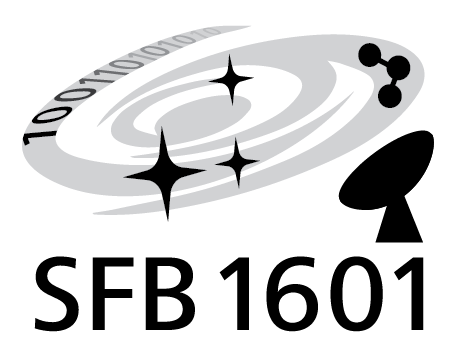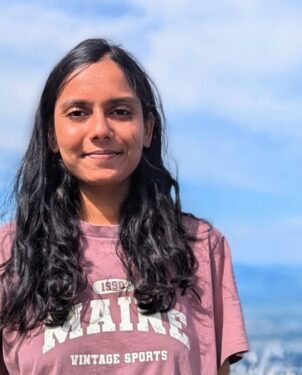Prachi Prajapati, an observational cosmologist working at the Max Planck Institute for Radio Astronomy and affiliated to the University of Cologne, participated in the 73rd Lindau Nobel Laureate Meeting. She reflects on her career so far and the time she spent in Lindau.
As a school kid growing up in India, I was interested in science in general. When Sunita Williams, a NASA-astronaut of Indian origin, flew to space for the first time in 2006, I closely followed the news covering that event. That interest in space science stayed with me; and having finished school, it was an apt choice to apply for a bachelor’s in Engineering Physics at the Indian Institute of Space Science and Technology (IIST), followed by a master’s degree in Astronomy and Astrophysics.
After graduation, I was immediately placed to work at the astrophysics department of the Indian Space Research Organization, where I also experienced many night shifts for observations at optical infrared telescopes on the hilltops in Western and Northern India. One of the best things was to see the Milky Way with naked eyes. The job included mainly R&D tasks, including the back-end instrumentation for ground-based telescopes. After three years, I decided to go back into academia. Since autumn 2023, I am pursuing my PhD in Bonn-Cologne, Germany, at the Max Planck Institute for Radio Astronomy.
Birth of Stars, Galaxies, Clusters and Super Clusters
Galaxies are constituted of stars, gas, dust, and dark matter. Basically, my PhD is focused on understanding the process how galaxies are formed and evolved in the history of cosmic time. Big bang is one of the most popular theories for the beginning of universe. Tracing the star formation history using the cold molecular gas lines, we are trying to find out how and when different galaxies were born after big bang, how they developed over time to become what they are at present. For analogy, it is similar to human evolution; the Darwin theory says that maybe we were monkeys and eventually we developed into the human shape as we are today – so there is a link between the two stages which is called evolution.
We observe the high-redshift galaxies using radio and submillimeter telescopes, doing multiwavelength observations of the galaxies starting from the epoch when the universe was about a few hundred million years old, until now. Eventually, the aim is to observationally understand the overall picture of the universe from the earlier epochs (high-redshift) to the stars and galaxies that we see today all around us to find out how these large structures were formed. At the same time, we all are part of the Milky Way, which itself is a part of the local cluster which is a cluster of galaxies. Now we also know of the existence of super clusters that are clusters of clusters of galaxies.

The Majority of the researchers in this research field try to understand physics at all these different astrophysical scales to answer numerous open questions. This is fundamental physics, which is not immediately affecting the humanity, but it is more of a curiosity-driven research to fulfill the inner quest for understanding how the nature works. Maybe in the future it might have some societal implications – who knows?! For example, Einstein’s general theory of relativity was a pure theoretical beauty, which led to GPS applications after almost a century and now it is an integrated part of our lives.
Real Life of an Astrophysicist
Many people imagine an astronomer looking at the sky with a telescope at night – of course, that is one part of it, i.e., we have ground-based optical-infrared telescopes which are operated only at nighttime – but we also have space telescopes like James Webb Space Telescope (JWST), Hubble Space Telescope (HST) and Chandra X-ray Observatory, which are always in the sky taking observations. In addition, we also have ground-based radio-submillimeter telescopes, operating at longer wavelengths. These waves are observable also during daytime from Earth as the atmosphere is transparent for them and the sunlight in radio is not super bright, so they do not need to be observed only at nighttime. Such multiwavelength observations using different observatories provide a holistic understanding of the astrophysical targets we look at. Now with advancements in technology, most of the observatories are working automatically, and one does not have to be on-site for observations; but it is good to learn how the observations are realized. This was the reason why I visited the Karl Jansky Very Large Array (VLA) in the United States once to experience the techniques using with which the radio data for my PhD was observed. But in fact, most of the time, I am not looking through a telescope – I am sitting in front of a computer screen either coding or using software for data reduction. Not all the data we observe are perfect, so one has to remove the noises caused by unwanted radio frequency interference (RFI). For our observations, signals from mobile phones, WiFi, Bluetooth, orbiting satellites, etc. are negatively impacting the data as they also transmit similar frequencies like those we are using in radio observations. Handling large data volume is also an important aspect for all observatories, in particular for radio telescopes, as the amount of data is increasing. Upcoming radio observatories like SKA, the Square Kilometer Array in Australia and South Africa, will achieve around 700 petabytes per year.
Proposals and Future Perspectives
We receive most of the data remotely via our accounts on the observatories’ websites, for which we had submitted proposals. Proposing for observations is also a crucial part of the PhD – scientists are motivated to submit observational proposals for making new observations. This process is quite competitive because the telescopes have limited timeslots for observations and there are lots of researchers from across the world competing for them. Some of the most demanded telescopes are JWST for infrared bands, VLA for
radio data, and ALMA for submillimeter. After a successful proposal and getting promising results from it, we have proposed for more observations in the coming cycle of VLA; however, due to the competitive run on the telescopes, I need to have a plan-B for my PhD. It is important to be prepared to use some other archival data to accomplish the aims of my doctoral research project, if the latter proposal does not succeed. I am particularly interested in looking at galaxies farther in distance, in the high-redshift universe, which
also means that I am really probing the faintest signal that one can get from the early universe. The future in the field is promising with the latest/upcoming observatories like JWST, ngVLA, and SKA.
My plan is to go back to India as an academician and make use of my knowledge and of western collaborations to promote the field in my home country, and facilitate younger generations to conduct good science.
My Lindau Experience
One of the opportunities to connect with other scientists and the Nobel Laureates was the Lindau Meeting. I met so many people from across the globe – and I am still in touch with many of them. The interdisciplinary aspect of the Meeting amazed me. It was quite fruitful to attend the Lectures by Nobel Laureates, not only on science but also on outreach, learn how they are trying to change the academic systems in different countries and doing promotion of science. Participants were always encouraged to keep an open mind and to explore unknown fields of research. It was a perfect mix of life, philosophy, and science!

Additionally, I was a part of one of the Sciathon groups this year and our project got shortlisted, which meant we had the chance to discuss our project during the Sciathon Forum. This is a good platform for people who are interested in startups: talking to experts from industries and academia, getting their input or suggestions to modify things in the project – and even to be appreciated that you are doing a good work, that provides motivation to continue.
My advice to future Young Scientists: Talk with as many people as possible. Connect with them. And enjoy your time there at Lindau for a life-long experience!
Prachi Prajapati, 2024 Lindau Alumna, is conducting observational cosmology at the Max Planck Institute in Bonn, Germany. After having completed her bachelor’s and master’s degree with a major in astrophysics, she was working at the Indian Space Research Organization for about three years, before she decided to pursue her PhD. She aims to understand the early history of the universe based on the data collected by telescopes around the world.
Text and photos: Prachi Prajapati
Original Article:

